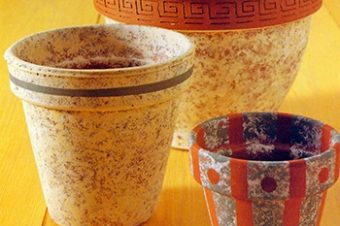Floors, Furniture and Fabric Stencil Magic

Stencil decoration on surfaces other than walls has a long history, and painted furniture, floors and even ceiling beams have brought color to traditional homes for centuries.

Stencils from the same set of designs give fabrics, furniture and walls a totally coordinated look. The designs are used complete and in adapted form, showing how many effects you can achieve from just two or three simple stencil patterns. For example, the tails in the scalloped border around the top of the room come from the ribboned bouquets, which are on the dresser doors. Traditional circlets of laurel leaves form a sinuous border above the skirting and down the edges of the decorative bed drapes.
Stencil Furniture
Although you might never decorate a valuable or antique piece of furniture, you can use stenciling on everyday pieces and bargain furniture finds. It will enable you to create a convincing rural, peasant-like effect. For this, choose mellow, dirty colors and distress both the back-ground and the design.
Alternatively, stencil trails of flowers over smartly painted built-in wardrobes, for a fresh feminine look, or add perfectly stenciled motifs to richly colored furniture or even modern kitchen units. Using the same or related stencil designs on the furniture as for the walls of the room will integrate the furniture in a coordinated scheme. Painting and decorating a single item of furniture independently gives it an impression of rarity and value.
Stencil Floors
Stenciled floors have a naive and exuberant charm. Use a bold, all over pattern if there is little decoration elsewhere in the room, or stencil a wide border around a carpet square, leaving a central area of stripped boards.
Another approach is to paint a rug design on the floor in the center of the room – some tile patterns available in stencil form are suitable for this. Or stencil a rug in front of the hearth, or as a runner along a much trodden path. Protect the design with two or three coats of clear varnish.
Finding Stencils for Floors
Most ready-made stencils are too small to decorate a floor because their neat designs are barely visible from a distance. It is best to search out big, bold patterns that will show up. Alternatively, enlarge smaller ones using a photocopier and re-cut them.

Decorate plain curtains with stenciled borders. Choose a design in proportion to the size of your window and use it to give as much or as little color and pattern as you want. Here, the design is used again horizontally along a valance. The tie-backs use the same stencil in yet another way. You can make them by cutting around the design outline to give a shaped edge and are then trimmed with fabric fruit and leaves.
Stencil Fabric
Plain furnishing fabrics acquire an exclusive hand-printed look after stenciling. Borders, panel designs, and sprig motifs are all suitable for decorating fabric. But once again, choose designs in proportion to the items you plan to make from the material. Remember, too, to test out the designs on a scrap of spare material before you start. Bear in mind that the colors may change slightly depending on the type of fabric used.
The texture of the surface you’re stenciling will affect the design in different ways. Smooth surfaces accept designs well, showing all the detail. But coarse textures, like wicker and hessian, give a less distinct image. See our page “Stenciling-Getting Started”
Reference: The Country Look—Decor & Crafts, Main picture by Janek Szymanowski










2 Responses
Magic, Marvelous, Easy Wall Stenciling - Crafting DIY
[…] All-over stencil designs are more labor intensive than borders, but can give stunning results. Consisting, usually, of a small motif repeated at regular intervals over the wall and perhaps teamed with a stripe or trellis grid, they can form part of a coordinated scheme with the same motif appearing on fabrics or furniture. […]
How To Do Wood Staining - Crafting DIY
[…] floor is infinitely cheaper than laying carpet or tiles. Already divided into parallel strips, the boards can be stained in stripes, panels, zigzags or mosaics of different […]